You know it’s spring when baby chicks arrive! Familiarizing yourself with the in’s & out’s of baby chick care will ensure these sweet little fuzzies continue to bring joy & smiles to everyone they come in contact with.
This post may contain affiliate links at no additional cost to you. By making your purchases through the links on this website, IMSL may make a small percentage at no direct cost to you. IMSL only promotes products we use & truly believe in. Please refer to my Privacy & Disclosures for further information. IMSL thanks you for your support!
There may be nothing quite as fun & rewarding as welcoming these fuzzy, soon to be feathered ladies, to our homestead on the hill. Although exciting when first beginning the journey to “chicken-hood” (yes, you are now their mother if a mother-hen is not present), there are a few simple steps that need following to ensure success of your brood.
As with any new “mother”, our job is to provide food, water, & shelter for the new arrivals. All that with the added addition of a little bit of love 🙂
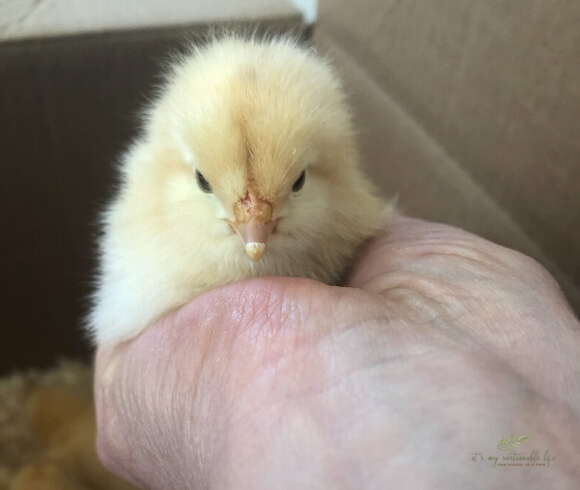
BABY CHICK FACTS
As with any new endeaver, familiarizing yourself with the terms used in the project ease the learning curve greatly. Raising baby chicks is no different. Knowing a few terms and chicken facts can guide you to success when raising your baby chicks, especially when purchasing them.
- Chicks – any baby chicken is called a chick no matter female or male
- Clutch or Peep – A group of chickens or baby chicks is called a clutch or peep
- Pullet – An immature female chicken (typically less than 1 year old)
- Hen – A hen is an older or mature female chicken (as they begin to lay eggs at 16-20 weeks)
- Cockeral – A young baby male chicken (under 1 year old)
- Rooster – Male adult chicken
- Flock – A group of adult chickens
- Brood – A group of adult hens
When trying to create a brood of laying hens (adult females that will produce the much sought after eggs), it’s important to note that sexing (determining males from females) is difficult if not impossible until the ripe old age of 6 weeks.
FUN CHICKEN FACTS
A few fun facts about baby chicks and chickens are always entertaining & at times educational. Here are a few.
- Eggs – A hen is born with a predetermined number of eggs. No prompting or supplementing will change how many eggs that hen will produce in her lifetime
- Egg Color – The genetic makeup of the hen will determine the color egg she will produce. For example, Ameraucana’s are known for laying varying hues of blues, Buf Orpingtons will lay brown, and Leghorn’s will lay white eggs
- Larger Eggs – Older, adult hens will lay larger eggs more often, & younger laying hens will lay fewer smaller ones
- Fun Facts – Chickens can remember up to 100 faces, can taste saltiness but not sweetness, they can dream & see in color, when stressed they lose feathers, they possess over 30 different sounds to communicate, Mother Hens will “talk” with their chicks while still in the shell & the baby chicks can “talk” back, & they possess 3 eyelids
PURCHASING BABY CHICKS
There are multiple ways of acquiring baby chicks. Some we have found to be better than others. Options include local purchasing from farms & feed stores, online ordering & delivered via the postal service, and even from friends who raise their own.
BACKYARD CHICKEN JOURNAL – ORGANIZING FROM THE START
STOP! Before you commit to purchasing and raising backyard chickens, organize yourself from the start! I’ve create a Backyard Chicken Journal to help with just that. Getting organized.
With ten whimsical pages that you can print to your hearts galore, covering everything from income & expenses, to egg production, flock information, incubation & so much more, I’ve got you covered. Grab your download today and set yourself up for success. Chicken success that is 🙂
Once you have your backyard chicken journal in place, there are a few deciding factors may sway you in how you acquire your baby chicks.
DECIDING ON BEST AGE OF BABY CHICKS
Depending on the age of the chicks you are purchasing will determine how long you have to wait for the egg arrival. Consider the following prior to purchasing your chicks.
DAY OLD CHICKS – Day old baby chicks are available with online ordering, & at times at your local feed store. The most cost-effective method for purchasing day old chicks is via online ordering. We highly recommend ordering through a reputable source, (Murray McMurray Hatchery is our favorite online source), typically .50 cheaper than those at the local feed store. Online suppliers offer reduced prices per bird when purchased in higher numbers.
PULLETS – The older the hen (closer to laying those precious eggs), the more expensive. Typically pullets are about 20 weeks old and can be ordered through online sources as well as sourced locally.
HATCHING – There is always the option of hatching your own chicks if you already have an existing brood as well as a rooster (to fertilize the egg). Check with your local zoning ordinances to confirm roosters are allowed! Many urban centers allow laying hens but not early crowing roosters 🙂
When considering hatching, be sure one of your hens is “broody” (the hens instinctive urge to sit eggs until they hatch). A broody hen will lay on the eggs and peck at anyone trying to remove that egg. You can always hatch your own with an incubator, but that is a topic in of itself (and one we will be addressing soon!).
Mature Laying Hens – Mature laying hens are just that. Adult female chickens that are already laying eggs. These tend to be hard to come by, but often can be found via social media farm groups, or local farmers looking to replace their older ladies. Chances are you will need to consider the options listed above for acquiring your mature laying hens.
Battery Hen Caution – Battery hens are hens, in our opinion, that have not had a very good life. They are kept in very small cages, debeaked, and are typically laid out (not producing more eggs) at young ages.
DECIDING PURPOSE OF RAISING BABY CHICKS
Not all chicks are created equal. Yes, they are all cute, fuzzy, and adorable at very young ages. But as they grow, they definitely have different purposes in life.
Determining what you will be using your peeps for will save a lot of grief when raising baby chicks. After all, if you purchase “meat” birds when you are actually looking for layers, loss of time, investment, & energy is what you can expect. Some considerations to think of prior to ordering your brood can be found below.
- EGGS – When acquiring your flock of hens with gathering eggs in mind think of breeds such as Americauna’s, Leghorns, Buff Orpingtons, and other heritage breeds.
- MEAT – Birds raised for meat, aka broilers, have been bred to grow very rapidly & slaughtered for meat. Grown for approximately 5 weeks will result in a 4-5# chicken, grown for approximately 10 weeks will result in a 10# bird. Interested in broilers? Think Cornish Crosses.
- Pets & Ornamental – Yes, many are interested in raising chickens for their beauty, friendliness, & often to show at your local fairs & 4H competitions. Think Brahma, Cubalaya, and other heritage breeds.
Determining how you will be using your flock will determine which breeds are best for you!
BABY CHICK BREEDS
Before you buy, a few considerations of which breed suits your needs best should be looked at. Taking the time to research the different breeds, their docile(ness) or difficulty traits, their ability to adapt easily to your climate (hot or cold), & the average number of eggs (layers) or average growth size (broilers) is time well spent.
Our friends over at The Happy Chicken Coop have created a through list of chicken breeds from A-Z that is comprehensive and worth taking a look at when considering which breed is best for you.
UNDERSTANDING BABY CHICK ORDERING TERMS
There are several terms or definitions used by many companies for ordering purposes. Knowing these terms will make your ordering process a bit smoother.
- STRAIGHT RUN – An order consisting of unsexed chicks, consisting of both hens & roosters
- SEXED – Sexed birds implies just that. They have been “sexed” & hopefully you will receive just what you ordered. Typically sexed bird orders cost a bit more.
- PURE & STRAIGHT BREED – Birds that have not been bred with any other breed other than their own
- HYBRID – Mix of two or more breeds
- STRAIN/LINE BREED – Hatcheries “own” line of breed
- NPIP – The NPIP, National Poultry Improvement Plan, is a US federal program whose mission is to certify growers who test for certain diseases in their birds. Below, taken from NPIP’s website is a list of disease(s) presently being certified.
“The diseases covered by the NPIP are avian influenza (fowl plague) and those produced by S. pullorum (pullorum disease), S. gallinarum (fowl typhoid), S. enterica var. enteritidis, Mycoplasma gallisepticum (MG, chronic respiratory disease, and infectious sinusitis in turkeys), M. synoviae (MS, infectious synovitis), and M. meleagridis (MM, day-old airsacculitis). In addition, the NPIP has programs such as “U.S. Salmonella Monitored” and “U.S. Sanitation Monitored” that are intended to reduce the incidence of salmonella organisms in hatching eggs, chicks, and poults through effective and practical sanitation procedures at the breeder farm and in the hatchery.”
NPIP
Should you be concerned with any other diseases, it’s best to ask the breeder or hatchery directly if they have been treated or vaccinated for the disease.
BABY CHICK SUPPLIES & EQUIPMENT
As with any good mother, preparing for the arrival of the little one(s) is key to keeping sanity 🙂 Having your “home” set up for the baby chicks arrival will allow for a smooth & effortless transition.
Although baby chicks when first arriving can be kept literally anywhere, realizing the speed of which they grow should be considered. The cute, adorable day old chicks quickly grow to become messy & yes, a bit smelly cute little ones 🙂
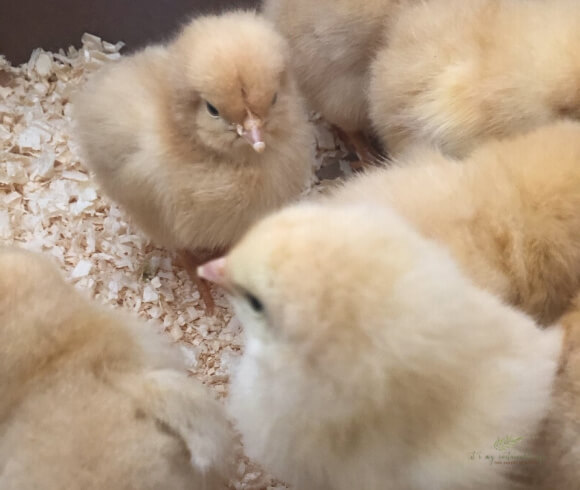
From arrival to introducing the flock to their outdoor space occurs with amazing speed. Literally within 4 week span of time! Needless to say & emphasize, preparing for the arrival is key to a smooth arrival day.
A quick reminder, that ordering through this site supports IMSL’s efforts of creating informative articles of interest at NO ADDITIONAL COST to you! As always, IMSL appreciate’s all your support!!
BABY CHICK HOUSING NEEDS
Depending the age of the chicks you purchase will determine the housing you will need. For general purposes, the needs of baby chicks will be discussed here.
Creating a warm, safe environment for baby chicks is key to their health & well-being. We utilize our garage for the purpose of raising our baby chicks. This keeps the mess at bay (chicks enjoy “scratching” & can create a bit of a mess as they explore their new space) & keeps them safe from predators.
Setting up your housing needs for baby chicks does not have to be expensive. There are expensive options available that would work amazingly well, but unless you are raising a LOT of babies, more frugal options can be set up for the short time they are there.
When purchasing very young, day old chicks, we set up a makeshift brooder using just a cardboard box with the bottom cutout & place it inside our next stage (dog fencing crate with the bottom removed works great with cardboard lined around the bottom edging displayed in the picture below). Note not shown in this picture is the heat lamp hanging from above. More on heat can be found below.
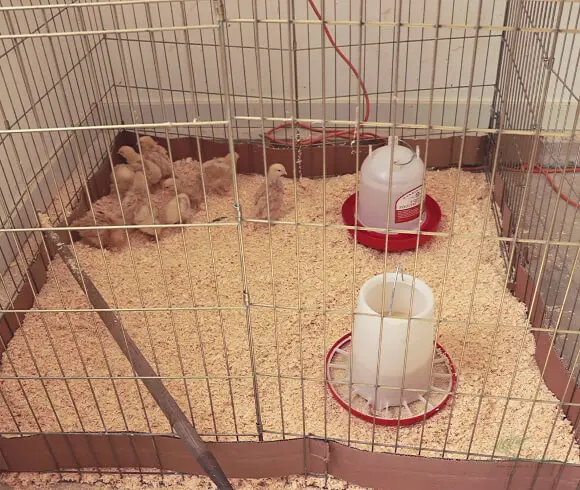
Whatever you choose for your brooder, a cardboard box, a large plastic bin, or a purchased brooder, the brooders functions need to cover the following basics.
- SECURITY – Baby chicks can be great escape artists. They are small & can find any escape route that may be available. Whatever brooder you choose should keep them safe & secure within their boundaries.
- SAFE FROM PREDEATORS – Rodents, dogs, cats, & other animals can all be considerdered predators to these small fuzzy chicks. Ensuring a safe environment that cannot be accessed by any predator is a must.
- FREE FROM DRAFTS – Providing a draft free environment is a must with young chicks. Cold & drafts can result in quick deaths.
- VENTILATION – Good air-flow & ventilation is a must with any brooder placement.
- DRY SPACE – Not only is cold a sure fire way to a quick death, wet conditions are as well.
- ADEQUATE SPACE – Chicks need room to roam. At a minimum, 2 square feet of space per bird is suggested, but we always offer more. As they grow, so too should their space to roam grow.
- STABILITY – Providing a stable flooring on which they can move around on is key to preventing a permanent deformity called “splayed leg”. We have found newsprint works just fine & have never had an issue with this disability. However, other options are paper towels, or even pet pads will work. Whichever option you choose, they need to be changed often for these frequent poopers 🙂
Approximately two weeks after their arrival, they will need to be transferred to a larger space. As all chickens, babies included, enjoy roosting (the space the birds stand on to sleep & rest), the addition of a pole or branch to their new space is always much appreciated by them.

BABY CHICKS HEAT LAMP & WARMTH REQUIREMENTS
Baby chicks like to be warm. Really warm. Like sauna warm. The first week of their lives, they prefer a balmy temperature of about 95 F to 100 F!
As they grow, each week, the temperature can be lowered by 5 F or until the temperature of their environment is the same as in their brooder or they are fully feathered at about 6 weeks of age.
Equipment options vary widely & is a personal choice. Fires have been caused by the infrared heat lamp bulbs (250 watt). That being said, we, personally have used this method of heat for our chicks for many years. With proper care & observation, this low-cost heat source works fine.
Other heat options are sweeter heater, a chicken heat source that touts the following…
- Safe, energy efficient, indestructible and reliable.
- No hot spots and develops a uniform heat pattern, using less power
- Internal Thermostat that will automatically shut the unit off if heat is not allowed to escape
- Overhead Mount (top) for suspending overhead, chain & hooks included
- Sweeter Heater has been tested and proven by our customers since 1995
The Brinsea Ecoglow is another heat option that is reputably safe. Although not cheap. This brand states the following about it’s product.
- Brooder for warming newly hatched chicks or ducklings
- Radiant-heated underside for producing uniform temperature and minimizing power consumption
- Three adjustable height settings for accommodating various chick sizes
- Indicator light for confirming brooder is connected
- Measures 12.0 x 8.0 x 8.0 inches (L x W x H) for holding up to 20 chicks
And finally, the third options is the Cozy Coop Heater. Definitely a more cost effective option.
The 200 watt heat source is safe for coops & according to the manufacturer, & safe for small animal houses.
We highly recommend doing your due diligence when selecting your heat source & make the decision based on feedback, safety, & ease.
WEEK BY WEEK TEMPERATURE NEEDS FOR BABY CHICKS
A general weekly guide to the temperature needs of baby chicks is as follows….
- WEEK 1 – 95 F to 100 F
- WEEK 2 – 90 F TO 95 F
- WEEK 3 – 85 F to 90 F
- WEEK 4 – 80 F to 85 F
- WEEK 5 – 75 F to 80 F (remove the heat source when the outside temp is the same as in the brooder)
- WEEK 6 – 70 F to 75 F (baby chicks at this point should be fully feathered & fine without heat source)
ADDITIONAL HEAT SOURCE NOTES
Should you choose a heat source without a light option, we recommend you leave the room or space light on for the first week at least so they can find the heat source in the dark.
Should you choose the infrared light option (we recommend a brooder option with bulb guard) we recommend using the red bulb options. Red light is a dark, warm option that will allow those little ones to sleep a bit better & peck one another a bit less.
When using a heat source be sure to keep a close eye on the babies & observe their behavior. Their behavior will tell you if the heat is just right or too hot. Crowding under the heat source, lower the lamp or heat a bit to allow for warmer temps. Running to the edges of the brooder will determine it’s too hot. Happy babies will be running around the brooder exploring.
BABY CHICKS FEEDERS & WATERERS
Baby chicks have specific needs for both feeders & waterers. Not just any bowl will do as newborn chicks can easily drown & also poop, walk in it, & spill both water & food.
Personally with our love of all things mason jar, both the feeder & the watering versions we use attach to mason jars, are cost effective, & more importantly safe for the babies.
These mason jar options are quickly outgrown however, and larger options will need to be utilized after the first 2+ weeks.
LITTER OPTIONS
As state above, for the first two weeks in the smaller enclosure of our brooder space, we utilize several layers of newsprint. We have had great success using this easily accessibile “litter”. It changes out easily & can be sourced free of charge. WIN! WIN!!
Once we open up their enclosure or brooder to the larger space after the first few weeks, we begin to use pine shavings. We have found these to be absorbant & easily cleaned. The baby chicks seem to love scratching around in them for amusement as well.
There are a few other options you may want to consider.
- SHREDDED PAPER – Not as absorbant as pine shavings & quite frankly a pain to work with
- GRASS CLIPPINGS – We personally have never used this option, seems a bit more labor intensive. But as long as they are untreated, chemical free clippings, give them a try if you like!
- SAND – Again, we have not used this method for several reasons. We set up our brooder in our garage space & carting sand seems very labor intensive. Sand also does not insulate well (remember, baby chicks like it warm!), & certain types of sand, aka sandbox sand, can easily be eaten by the babies & cause impacted crops resulting in death.
- HEMP BEDDING – Although we have not used this type of bedding option, it claims to be as absorbant as pine shavings & is a wonderful renewable option we may give a go in the future depending on cost
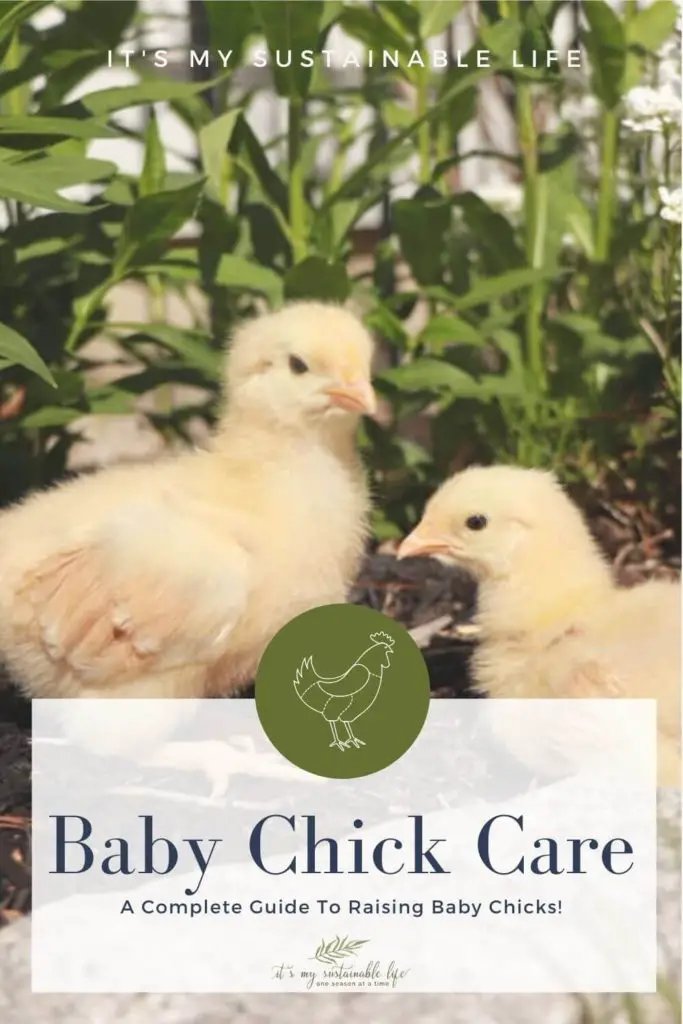
WHAT TO FEED BABY CHICKS
Fortunately, in modern times, feed companies have taken the guesswork out of what to feed our newborn chick babies. These feeds, “starter feed”, “crumbles”, or “mash” are all formulated with the chicks needs in mind.
These starter feeds should be utilized according to the manufacterer’s labels & should be used anywhere from the first 4 weeks to 16 weeks of growth periods.
As with anything today, not all feed companies are equal. Special note: if your chicks have previously been treated for “Coccidiosis” you will need to feed un-medicated feed options only. If they’ve only been treated for “Marek’s Disease” then medicated feed is an option for the first few months should you choose that route.
Another, and more wise choice in our humble opinion, is feeding organic options that are free from the use of harmful ingredients. Our preferred feed source is from Green Mountain Feeds & we utilize their products religiously & with great success. We receive no affiliate benefits from Green Mountain feeds, but love their company, their products, & sharing with you because of that.
Baby chicks food & water should not be rationed. Give them free access to food & water at all times. Baby chicks will regulate their own food & water needs & not overeat or drink.
HOW TO CARE FOR BABY CHICKS
Now that you have all your equipment & supplies needed for your new arrivals set up & ready to go, once you are given the date of arrival you can go ahead and pre-heat their brooder by turning on the heating source. If you are using a heat lamp, you will need a thermometer placed directly under it to set the heat to 95 F to 100. To adjust the heat, simply raise or lower the lamp.
When ordering your baby chicks online, for those with young children anxiously awaiting their arrival, you may not want to tell them initially of a few things as some chicks may not make the journey. If this is a concern for you, we recommend not telling them how many chicks you ordered, the arrival date & time, & not having them with you for first inspection of the baby chicks box. Losses are not always the case, but erring on the side of caution may save the little ones some despair should that happen.
BABY CHICKS ARRIVAL
Once you receive or bring home your new additions, place the container they arrived in close to or even better yet, inside the brooder. One-by-one, pick up a chick & with firm but gentle pressure, dip their beaks in both the feeder & the waterer. By doing so, they are now familiar with where to reach their food sources.
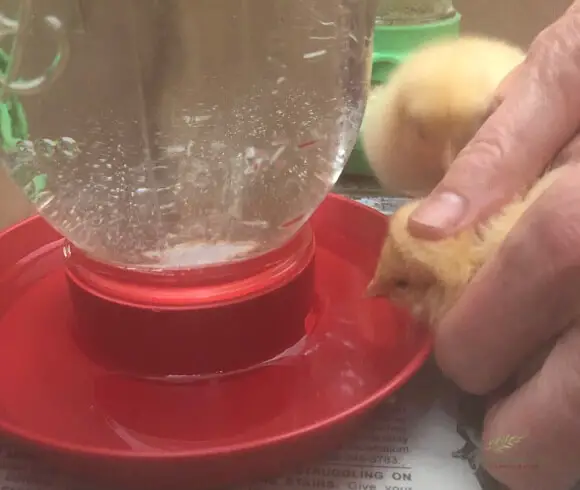
We like to let them be once they have been orientated to their food & water. After all, it’s been a long & stressful transition for these little beings!
We do, however, keep a close eye on their brooder for the first day or so. Making sure their temperature stays within the guidelines, they know where to reach their food & water, & that they are settling in without issue.
DAY TO DAY HANDLING & CARE OF BABY CHICKS
Once your peeps have settled in, you can now begin to socialize them. If you are looking for friendly chickens, plan on spending as much time handling, talking, & petting them as you can spare.
Keep their brooder, food, & water as clean as possible. This may mean changing water & food several times a day as baby chicks are messy. Obviously, it won’t be spotless, but a little upkeep will go a long way in preventing diseases such as “brooder pneumonia” which can be caused by damp, moldy bedding.
The rapid rate of which baby chicks mature will astound you. Below is a guideline of their growth habits.
- 0-2 WEEKS – Baby chicks downy coverings begin to be replaced with feathers. You will see rapid growth during this time period
- 2-4 WEEKS – Baby feathers are being replaced by adult feathers. Not the most attractive period for any bird to say the least 🙂 They begin their pecking order (the natural determination of the strongest on top)
- 4-6 WEEKS – All adult feathers should be in by this time & independence created amongst the flock
- 6-8 WEEKS – Pecking order has been established & have almost reached adulthood
IMPORTANT HEALTH INFORMATION FOR BABY CHICKS
Happy, healthy baby chicks, will run around exuberantly, taking naps under the heat every so often. They are eating & drinking, & look alert. Chickens do have a few health issues you may want to be on the lookout for, however.
UMBILICAL CORD ON BABY CHICKS
Every once in a while you may receive a baby chick with its umbilical cord still attached. The umbilical cord will look like a thin, black string that is attached to its rearend. Under no circumstances should you pull on this to remove it as it can cause injury! Simply leave it alone, it will fall off naturally.
PASTING UP OR PASTY BUTT
During the first week or so, keep an eye out for a condition referred to as pasty butt or sticky bum. Pasting up is where feces & bedding can gather & remain on their bums, blocking their vent. This can be deadly for the baby chick & should be taken care of immediately.
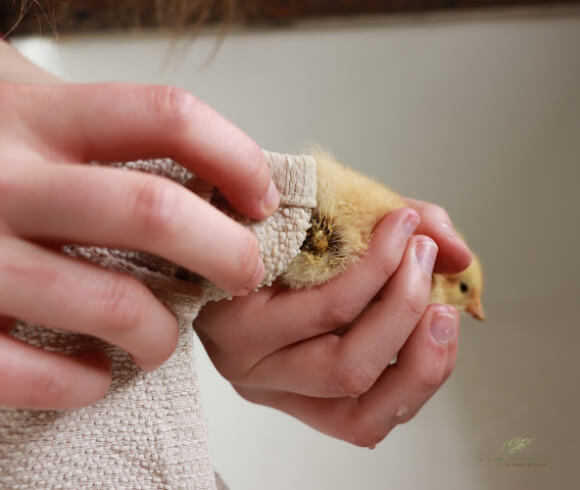
To clean, bring the chick to an area with access to warm water. Using a rag, gently soak the area with the warm water, losening the mass & wiping away as you go. The baby chick will not enjoy this process, so be prepared to be gentle but firm. Make sure the area is as dry as possible prior to returning the baby to the brooder.
At times, this will re-occur, so keep vigilant in inspecting those tiny butts 🙂 Wash & sanitize any area you & the chick have been in touch with, after all it is poo!
SPLAYED LEGS
When a baby chick develops splayed legs, aka spraddle leg, you will note that the baby chicks legs are spread or stretched out on either side of their body instead of underneath them. As they will not be able to walk properly or function normally you will want to treat this issue as soon as possible.
Treatment at this early age is simple. The legs must be hobbled or braced together so that the bones & muscles can begin to grow & mature in the correct position.
To hobble, you have your choice of materials to use. Bandaids, elastics, vetrap, and even yarn can be used to correct this issue. My friend, Kathy, better known as the “chicken chick” has a wonderful tutorial on how to correct this issue using vetrap. We have been fortunate in the 15+ years of keeping chickens, we have never had to deal with this issue. I’ll heed her advice should we ever have to deal with it!
TWISTED NECK
Twisted neck, aka stargazing or wry neck, is where the baby chick cannot physically hold its neck up. Its head literally falls back onto its back, thus the term stargazing. Baby chicks with this issue are unable to walk without falling over, thus impeding its ability to function normally.
Treatment with vitamin E and selenium as well as water soluble multi-vitamins, probiotics, & electrolytes can often aid chicks with this ailment. Consulting your vet is recommended for appropriate treatment options.
CROSS BEAK OR SCISSOR BEAK
This genetic deformity is where the top & bottom of the birds beaks do not line up correctly making it difficult for the bird to eat. Although there is no cure for the animal, carefully trimming the beak as it grows to keep the beak as aligned as possible is an option. Severe cases of this ailment may require separate feeding setups for the bird & in worst case scenarios, surgery.
STARVE OUT
Should you find that your new arrival is not eating, & has no interest in food & water, it may be from an ailment called starve out. Starve out occurs when baby chicks have been in transit without food & water source for too long a period of time.
As time goes, the baby becomes more weak with no motivation to eat or drink and literally starves themselves to death. Treatment is hit or miss with this issue. You can hand feed the baby by using the following guidelines offered by HTR Chickens for hand feeding found below.
- Moisten the feed in water and make a thick gruel that is just thin enough to be pulled into a dropper or syringe.
- Pull the the gruel into the dropper or syringe, and place the tip of the chick’s beak inside.
- SLOWLY push on the syringe or squeeze the dropper so that food goes into the chick’s beak. Administer the food SLOWLY; if you go too fast, you can easily drown a chick with the food. The trachea and esophagus are very close in the throat.
- Watch the throat to make sure the chick swallows.
COCCIDIOSIS
Coccidiosis is probably the most prevalent intestinal disease in chickens in which a parasite attaches itself to the chickens intestinal lining. This parasitic invasion prevents the chicken from absorbing nutrients vital to healthy living.
This issue is contagious, if one has it, prepare to treat the entire flock. Feeding medicated food helps reduce the risk of coccidiosis occuring.
Maintaining a clean & disinfected environment for the chickens is the best preventative measure one can take with baby chicks.
BLOOD IN FECES
Occassionally a healthy looking baby chick will have blood in its stool. If the baby chick is acting normally, eating, & drinking freely, its most likely due to the chickens shedding the lining of its intestinal lining, yes, chickens do that 🙂
If the baby chick is lethargic or acting unusual and not itself, separate the bird from the rest of the flock. Should more begin to display this same pattern, treatment for coccidiosis should be instituted.
Familiarizing yourself with the requirements for entering “chicken-hood” & caring for baby chicks may seem like a lot at the beginning. Taking it one step at a time, you will find yourself enthralled with your new role in no time flat.
Baby chicks are curious beings. Many love to be held, talked to, and made of. They never cease to bring a smile to our faces.
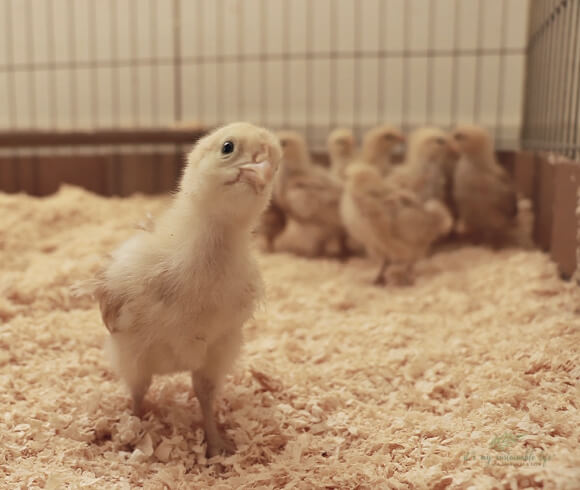
Do you already raise your own baby chicks? Have any advice we may have missed mentioning? Join our conversation below! As always, be sure to follow us on all social media & subscribe to stay up-to-date with the all the “happenings on hill”.
Love, Light, & Laughter ~

SHOP IMSL’S FAVORITES

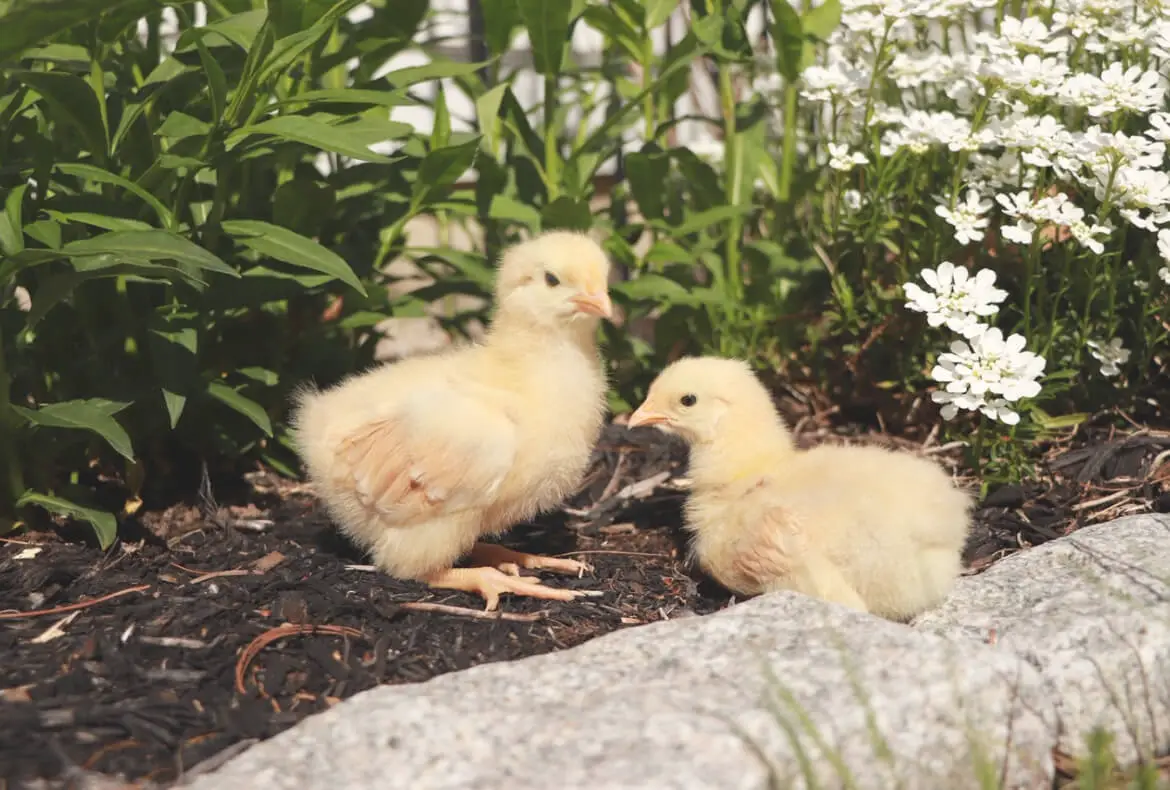
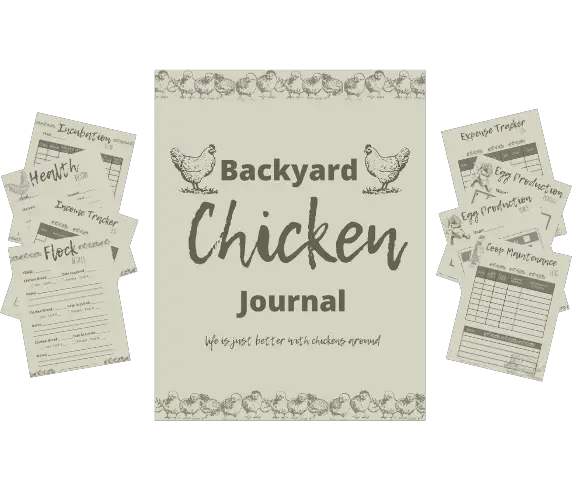

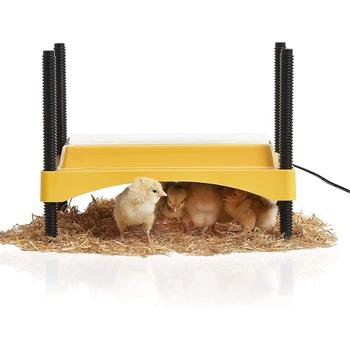
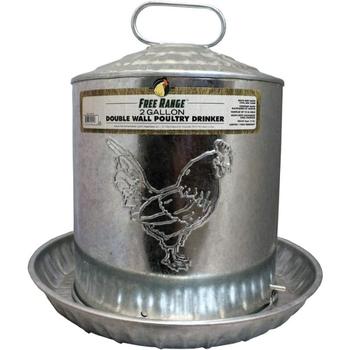

41 comments
Such a great resource for those interested in raising chickens! I love looking at the baby chicks in the local farm supplies stores.
I have such a fantasy to have our own little backyard chicken coup when we move somewhere that our housing allows it. There is so much to learn and this was such a good start for me to realize how much goes into it!
How sweet are they?! Just want to give them a cuddle!
Great information! What was surprising to me is how chicks can remember up to 100 faces. That’s incredible!
Great information. The whole “pecking order” thing has me a bit squeamish about getting chicks!
It’s not as gruesome as it sounds, lol! It’s natures way of determining the leader of the flock.
This brings back so many memories of getting our chicks. The best part is going to the post office and seeing all the patrons gawking over the sound of the peeping box!
This is such a thorough and informative post, definitely helpful for anyone entertaining the idea of raising chickens. My mom did for a while but then they moved and can’t have them at their new place. I know she’s excited to have them again in the future. All the kids loved playing with them!
This is such GREAT information! We just got our first chicks ever and took the time to learn a lot of this information so that we would be successful. We have three Cream Legbars and two Bielefelders. They are happily living in their chicken mansion now and have adjusted pretty well! I even got them to go home to roost in the evenings – win!! I’m excited as I learn more about my big mamas and hope that when they lay I can keep up with that new learning experience as well.
How exciting for you! It’s such a fun & rewarding experience.
So much good information here! I’ve been considering getting some chickens for my grandparent’s house while I’m there this summer. They used to have a small farm, but not for many years. I think chickens would be good there.
Oh, wow, this post really really well done! We learned the hard way that baby chicks can’t be alone. What is the minimum chicks you can have at a time? I’m also assuming that shipping chicks to Hawaii is probably not a very good option and it would be best to get it locally.
I feel like anything less than 3 would interfere with the social needs of the hens. Not sure about shipping that far, but who knows? Local is always best when in doubt for sure. Good luck!
We’ve thought about raising chickens. Our old neighborhood didn’t allow it, but our new one does. Not sure what we’d do with them when we travel though.
Chickens can be pretty self-sufficient for a few days at a time providing they have all their basic needs. Anything longer & I would definitely have a neighbor or friend take care of them for you. Good luck!
You almost make me want to raise chickens but living in an apartment in the city rules that out! Very informative!
I just love all your posts! We have thought about getting chicks every year. My husband really wants to do it, ME, not so much. I’m a prissy city girl brought out to the country. I pinned this piece as it is very informative and will be helpful if I give in to the husband. Thank you!!
Too funny! You may find you really enjoy keeping them! They are quite entertaining with the added bonus of the most wonderful eggs you will ever taste!
LOTS of information here! WOW! Super interesting!
I didn’t realize this was such a thing – I have THREE friends taking care of baby chicks right now! They look adorable but they all report the work required! I’ll send this their way, too!
Thank you for sharing this & for reading 🙂
We used to have chickens, and this makes me miss them so much. Our kids loved playing with them and the eggs were so fresh!
Such a cute post! I love learning all about this!
Oh my goodness! I feel like I could totally raise my own chicks now or maybe I can just help someone socialize theirs! They are so cute!
I had no idea that so much went into caring for a baby chick! this is very informative. And those chicks were so cute!
This may be the cutest thing I see all day, not to mention so informative!
Great information! My husband loves chickens! Just to watch them run around the yard and peck.
Thanks for the info!
I loved those fun facts! I remember when I worked at Disneyland we would get baby ducklings all the time and I would have to stand by them until horticulture could come out and help them because we couldn’t just leave them out in the pathway of guests because who knows what they would do to it. The babies were always so cute!
What a great memory! Babies of any kind just grab at your heart!
Such a wealth of information! I don’t think most people have any idea of what a real commitment it is to raise chickens. An acquaintance of mine purchased baby chicks for egg production, but had zero experience raising animals. All of her chickens met an untimely death, and the children were devastated. If she had the information from this post, I think she would have realized she was getting in over her head!
Oh, how sad for them! Hopefully they won’t make the same mistakes again. Feel free to share the info if you feel so inclined.
This is great info to share with the chick owners in my life. We don’t have any (I’m afraid my husky would get into them:() but have several friends/family that do. I love watching them.
Most dogs are surprisingly gentle if you train them from the get go when getting the babies. Thanks so much for reading!
Wow, I never realized there was this much to know and I also never realized how much chickens and humans had in common!
I never realized how much there is to do with getting ready for baby chicks! I live in a city setting and even though I have almost a quarter of an acre they do not allow chickens..This really makes me want some!
I love this! Our neighbors have chickens, they are amazing! I think this is also a wonderful learning opportunity for kids.
So adorable!! I had no idea of all of this work that came into raising chickens! What a great guide for anyone wanting to raise them!
Such an informative post! A must-read for anyone who is interested in raising baby chicks.
Wow a ton of information. So cute but what a commitment to do it correctly – which you owe to the work. Love your posts. Very interesting read for sure.
Would love to be able to do this… unfortunately I live in suburbia and we are not allowed. I grew up with my nonna raising chickens and rabbits in her yard. Was a great learning experience!
What a wonderful memory you have! Many urban centers are changing their zoning ordinances to allow for chickens. Hopefully, yours will follow suit soon! Thank you for reading & stopping by!